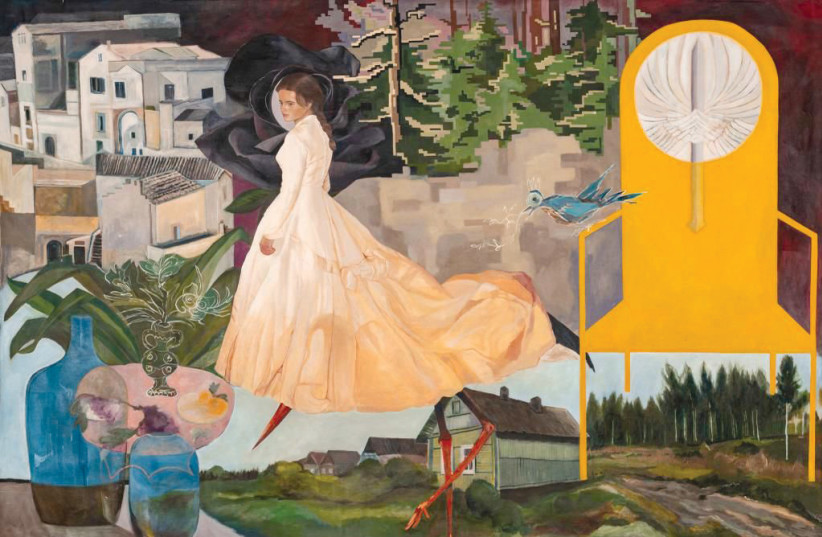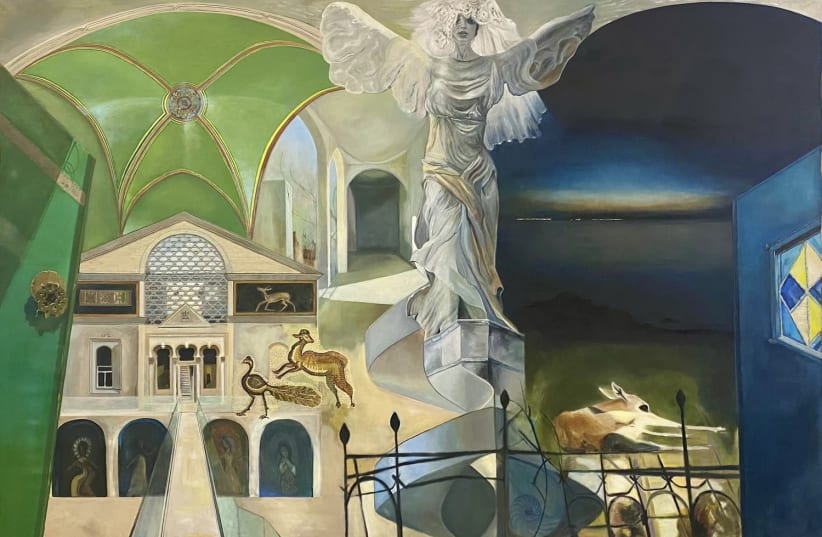

The Jerusalem Biennale has – for all the wrong reasons – been a long time in coming, but judging by the spread of over 30 exhibitions laid on at dozens of venues around the capital, March 10-April 29 we stand to get some recompense for the protracted wait.
The sixth edition of the artistic presentation was originally due to open last November but was put on hold following the terrorist attacks in the South.
The organizers say the biennale, under the aegis of founder and creative director Rami Ozeri, is “a resilient gesture that offers the healing power of art and creative expression to address the difficult challenges of our time.” That seems spot-on right now, and hopefully the paintings, engravings, drawings, and videos will help to ease the pain and sense of mourning we all share.
Some of the works have already seen the light of day abroad, with showings taking place in North and South America and Europe “in a display of solidarity with the people of Israel.” Now the world’s largest and most prestigious platform for contemporary Israeli art is up and running.
Israeli art show is up and running
If “The Doe of Dawn” exhibition is anything to go by, the bi-yearly splash is once again about to do Israeli and Jewish art justice. The show, which opens at the Bible Lands Museum on Sunday, engages in the mystical backdrop to the titular creature and, says curator Rachel Verliebter, addresses a range of layers and levels of human existence. That also encompasses the more obscure and loftier realms of our corporeal and spiritual being.


There is much in the way of Kabbalah and Jewish mysticism in general in the rollout over at the museum and welcome focus on the feminine side.
Verliebter invokes some sagacious insights courtesy of a 16th-century mystic to add collateral to the aesthetic offering and the thinking behind its various parts.
“The Arizal [aka Rabbi Isaac Luria] gave the secret, which is discussed in the Zohar, a very special meaning,” she says. Seems the celebrated Kabbalist may have inadvertently spilled some precious beans. “His student Haim Vital, when he wrote about the Arizal’s death, said it was linked to having spoken about the secret of the doe. He wasn’t supposed to have imparted the secret. It was something very holy. According to Haim Vital’s understanding, it had to do with great redemption, the rebirth of the people of Israel, during the crossing of the Red Sea.”
That brings us to the approximate environs of this time of the Hebrew calendar, with Purim just around the corner and then Passover. The former is featured prominently in some of the “Doe of Dawn” works, particularly in an installation and performance art contribution called Esther’s Throne by Alana Ruben Free, one of seven female artists on the exhibition roster, complemented by a single male counterpart, Meir Srebiansky.
The doe is also an important element of the approaching festive season.
“On the seventh day of Passover, the Kabbalists study the secret of the doe, the female manifestation of God, the Shechina [divine spirit],” Verliebter explains. “All the Kabbalah [writings] of Isaac Luria are about rebuilding the Shechina.”
The forward-looking and recuperative seam runs right through the exhibition. “We all yearn for change and rebirth, especially now,” says the curator, returning to ongoing troubling current affairs. “And now [post-Oct. 7] it has a much deeper symbolism and meaning. The feminine in Israel is so broken because of the hostages and everything that has happened.”
The temporal juncture significance inferred by the gentle female animal also relates to the diurnal-nocturnal cycle. “Chazal – the sages – attributed great importance to Ayelet Hashahar [The Doe of Dawn], the star Venus. And they saw in Esther this force. She is compared to the Doe of Dawn, bringing light from the darkest point in the night, bringing forth the light of the morning.”
THERE IS plenty to dig into across the exhibition. Iris Ahuva Pykovski, for example, has a full 10 items at the museum show which offer lots to view and ponder. Her paintings are replete with symbols and a plethora of objects and figures in curious juxtapositions.
One that really catches the eye and challenges the intellect is Bird Caught in Magic, which, Verliebter notes, feeds off the writings of legendary Jerusalemite poet Zelda. In fact, there are numerous strands to the reference points of the paintings, with plays on word meanings and religious leanings all woven into the stratified fabric.
“Iris Ahuva is a Chabad hassida [devotee], and the legs of the bridal figure in the painting are the legs of a hassida [stork].” There’s more. “Zelda was a very close relative of the Lubavitcher [Chabad] Rebbe, and the doe is called ‘hahassida bein hahayot’ [the pious among the animals].” To round off the bifurcated referential spread, Bird Caught in Magic is the name of one of Zelda’s many acclaimed tomes.
Pykovski’s The Doe of Dawn oil painting also packs plenty of hooks, including – naturally – a doe and four figures corresponding to the four biblical matriarchs, three of whom are buried at the Cave of the Patriarchs in Hebron, from where Pykovski draws much of her creative inspiration.
The building whose facade appears in the picture implies yet another topical and seasonal element. The curator says therein lies a remedial aspect. “Iris Ahuva told me that it is Beit Hadassah. Hadassah is one of Queen Esther’s names, and she does not have a grave that is accessible to us. She is buried in the Diaspora, in Iran. I thought that perhaps Iris Ahuva could include some kind of tribute to her. The painting also kind of offers itself as a meditation, a prayer.”
There is a gentleness and tenderness to the majority of Pykovski’s exhibits which suggest a feminine approach to corporeal and celestial domains. Intriguingly, other works in her share of the exhibition see her straying into more abstract areas, which incorporate far more strident polychromic choices.
Sandra Valabregue’s propensity for Kabbalistic takes is front and center in her five exhibits. They feature compelling shapes and forms and contexts, and her color combinations catch the eye and heart.
“She is a Kabbalah scholar,” Verliebter notes. “She wrote a PhD thesis about infinity. Her works are direct interpretations of mystical sources, like [first-century CE mystical tome] Sefer Habahir and angelology”.
Valabregue was well primed for the Bible Lands Museum venture. “She already had a work ready – Doe and the Dawn. And I think [Valabregue video work] Fruit Tree, Labyrinth is very representative of the divine feminine because you see the Sephirotic Tree [of Life] in beautiful feminine pastel colors. You see tree branches and also a womb.”
Verliebter was keen for the public to get as good a handle as possible on the intricately crafted work and all its component parts. “I asked her to transpose the painting into a much larger scale.” Hence the 1.5 m. by 1.5 m. video projection on the floor format. Valabregue’s mixed media triptych on wood panels, Fruit Tree Bearing Fruit, which weighs in at a hefty 3 m. by 2 m., also conveys the aesthetic and spiritual – bordering on the surreal – subtext loud and clear.
Contemporary climes come into view with Yifat Bezalel’s delectable Diana pencil on paper creation.
“There is all this symbolism and feelings attached to Lady Di,” says Verliebter, referencing the Princess of Wales, who died in a car crash in 1998. “Yifat is a renowned artist. She has already had a solo exhibition at the Tel Aviv Museum because she is such a gifted drawer.”
The curator follows the adored late British royal’s persona right into Jewish mysticism. “She told me this drawing matches my idea about the Shechina. She said that Lady Di represents the sufferings of the Shechina.”
Verliebter was all for it. “I said, that’s what I want, a modern version of malchut [royalty]. We have Queen Esther in a film and performance art. Yifat’s drawing offers a more popular, and more pop and modern take, that everyone knows of a queen-to-be who was so loved and so misunderstood. Everything she represents is the arousal of love.”
“The Doe of Dawn” exhibition appears to have plenty of spiritual, aesthetic, gender-related, and emotional bases well and truly covered, with hopefully a balm for our emotional woes in there, too.■
For more information about Jerusalem Biennale: http://jerusalembiennale.org and the Jerusalem Biennale Facebook page.












